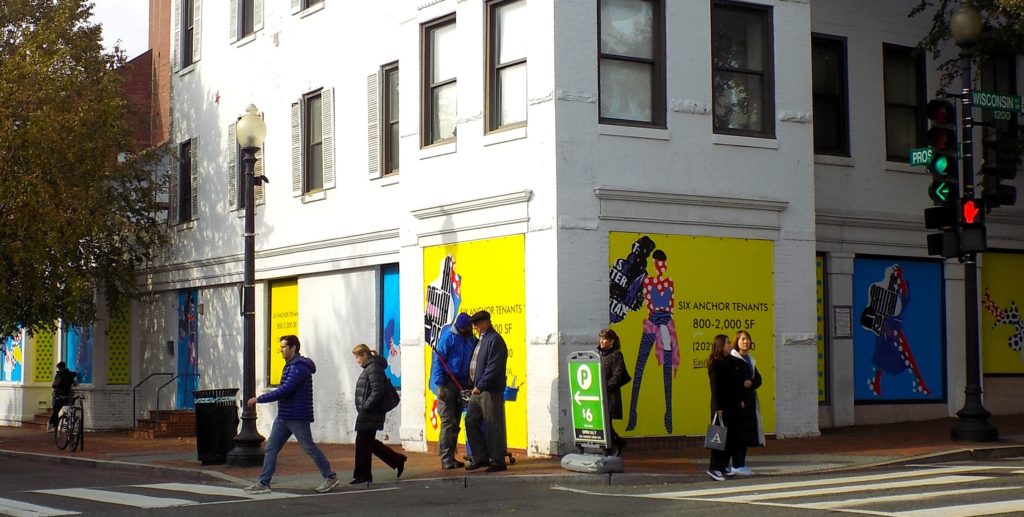Seeking Ways to Save Georgetown Retail
By • November 18, 2019 3 4654

More than 200 Georgetowners gathered on Thursday evening, Nov. 14, in the spacious vacant retail space of the former Georgetown Park mall to discuss — what else? — the problem of vacant stores in Georgetown. Sponsored by the Georgetown Business Improvement District, the meeting was co-hosted by the Citizens Association of Georgetown, the Georgetown-Burleith advisory neighborhood commission and Georgetown Main Street.
Ward 2 Council member Jack Evans addressed the crowd, asking: “What do you want Georgetown’s commercial district along M Street and Wisconsin Avenue to look like? We used to be known as a night entertainment center and as a unique retail destination.” He continued: “But both are mostly gone now and, despite millions of dollars in infrastructure improvement, Georgetown’s main business thoroughfares are dead right now.”
BID Director of Planning and Economic Development Jamie Scott reported that there is currently about an 11-percent retail vacancy rate. “That’s up from seven percent in 2015,” he said. “But of those, nine percent are truly vacant. The others have tenants or pending contracts and are awaiting approvals and reconstruction.”
High occupancy costs are one factor driving vacancy rates in Georgetown, according to Scott. Age, condition and configuration of the retail space are others, as well as complex building ownership arrangements. But online business doesn’t seem to be such a big factor here. About 10 percent of sales are online, and some brand-name internet retailers have opened up or are looking to open up brick-and-mortar stores in Georgetown, including Amazon.
“The biggest need in Georgetown is for more keystone cultural and entertainment businesses,” said BID CEO Joe Sternlieb. Such businesses are so popular and attractive that their overflow benefits other businesses nearby. In Northwest D.C., the Politics and Prose bookstore on Connecticut Avenue and Le Diplomat restaurant on Q and 14th Streets were cited as examples of keystone businesses that attract others.
After watching a series of slides on Georgetown retail, the crowd broke into three subgroups to share concerns and ideas about transportation and parking, regulations and retail. Preliminary summations found that the attendees were most concerned about the increasingly cumbersome, unpredictable and inconsistent review process of all projects by the Old Georgetown Board.
“Perhaps we need to prepare a white paper of obstructive cases by the OGB, as we did on the alcohol license moratorium, in order to foment change,” said BID Operations Director John Wiebenson.
But Hope Solomon, chair of Georgetown Main Street, suggested that rising BID fees from taxes, which had increased by 25 percent last year, were also detrimental to struggling small business.
The BID will be collating and analyzing notes and ideas garnered at the town forum to update its Retail Action Plan for Georgetown. Anyone wanting to add comments should email them to jscott@georgetowndc.com.


Georgetown has too much city-wide competition now, i.e. 14th Street restaurants, The Wharf (full the other week day when I was there for lunch; GT Waterfront upon my return via ferry was DEAD), City Center, etc. The OGB needs to get with the times and loosen their dictatorial grip. Rent subsidies, perhaps, should be made available for unique, independent shops, as Georgetown has become not much more than an outdoor, chain-store shopping mall. Widening the sidewalks on weekends was a good try, but had zero effect as to bringing in more shoppers – as far as I could tell. The intersection of M and Wisconsin needs to be turned into a pedestrian mall (yes, I know the headaches involved) occasionally or on weekends… but ONLY if something is added to make people want to come, i.e. flea market, pony rides, stilt-walkers, magicians, fire jugglers, mounted Park Police, live music (classical or opera – not that obnoxious, too loud music played at Taste of G’town), beer and wine available on the street, ping-pong tables, etc., etc. Philadelphia’s parks department has all kinds of crazy-fun things like that on their streets! Cities in Europe and South America are turning intersections into pedestrian malls all over the place; it’s time for Georgetown to look into it. If they can turn Times Square into a pedestrian mall, anything is possible!
The image in this article is my former club Scandals which was attached to my disco Tramp’s next door. I think one of the best solutions is definitely to bring back an entertainment vibe. Having said that I doubt that will ever happen due to the many restrictions and unwelcome environment that has existed for any type of establishment that serves adult beverages. I saw this all the way back in 1992 when I sold Champions and retired! Michael O’Harro
This article failed to hit on the biggest issue Georgetown has for potential shoppers. It’s getting there. Now with Tyson’s Corner, City Center, Pentagon City, and others which are easily metro accessible… why would you go to Georgetown? Georgetown is seen as a part of the city that is inaccessible unless you have a car. Why would I get off the metro when I can stay on it past Foggy Bottom to either Tysons or Pentagon City out in VA or City Center in Metro Center within DC? There aren’t any hip/popular bars or restaurants like other DC neighborhoods to draw people in. No night life what so ever. No noteworthy stores/brands that you can’t frequent elsewhere. Also once you get to Foggy Bottom station or Rosslyn… getting to Georgetown is a pain. So what exactly does Georgetown have going for it for a neighborhood that is essentially inaccessible.